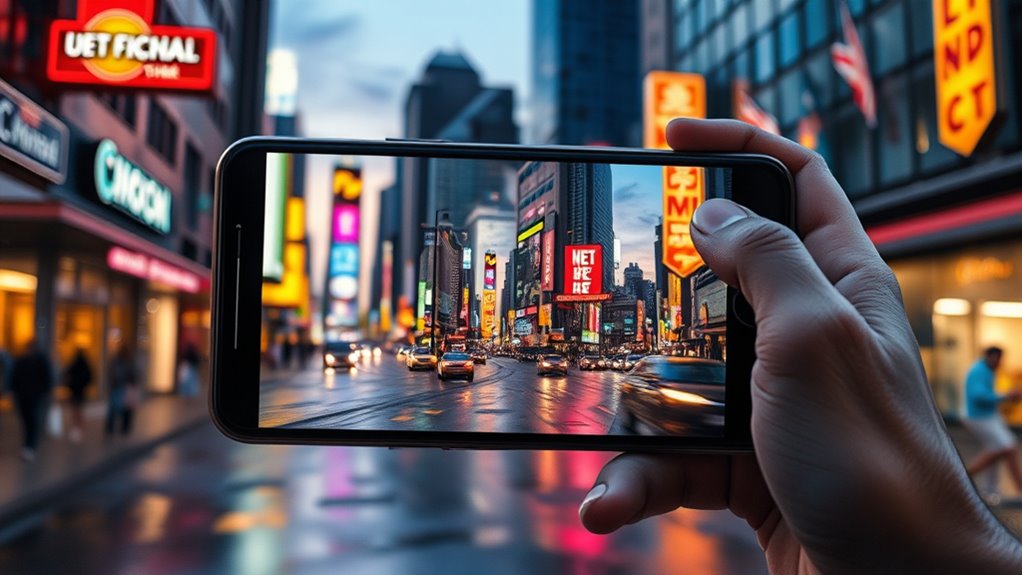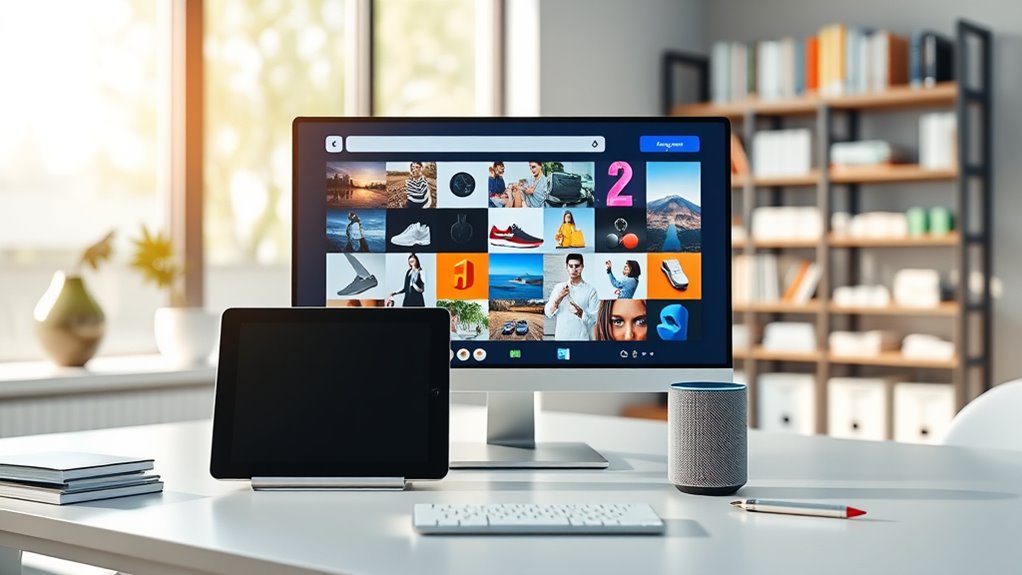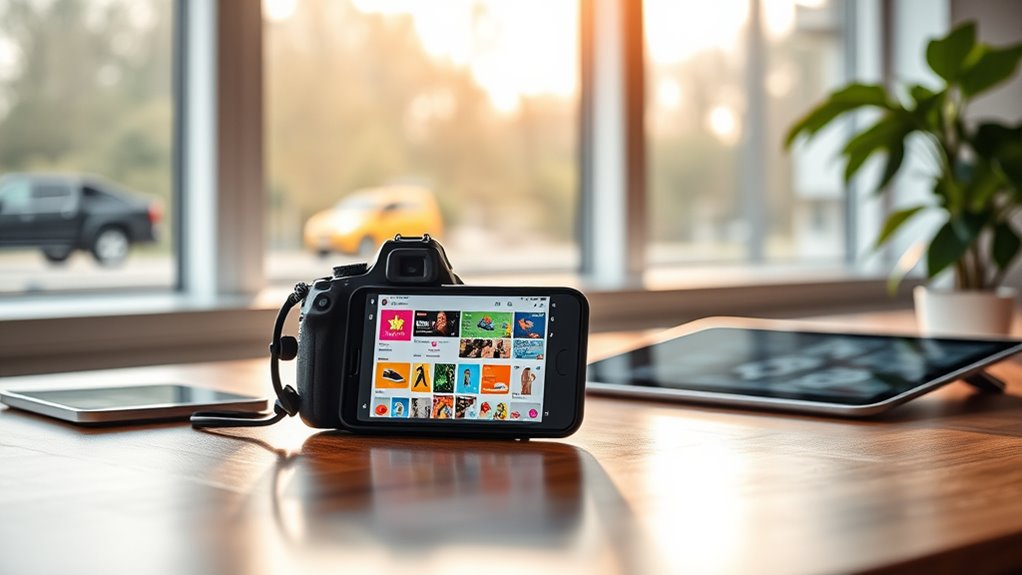The rise of visual search means you can now let consumers find your products using images or photos, making discovery faster and more intuitive. Advanced AI and image recognition power these tools, helping users identify items, locations, or brands instantly. As consumers embrace visual search for shopping and exploration, marketers must optimize visual content, use innovative platforms, and address challenges like privacy and accuracy. Keep exploring how to leverage this tech and stay ahead in your digital strategy.
Key Takeaways
- Visual search is transforming marketing by enabling more personalized, image-driven customer engagement and faster product discovery.
- Marketers should optimize visual content with high-quality images, descriptive tags, and structured data for better search visibility.
- Integration of visual search with AR and AI enhances user experiences, offering immersive and context-aware brand interactions.
- Leveraging platforms like Google Lens and Pinterest Lens can boost brand reach and facilitate easier product identification.
- Staying updated on evolving technologies and addressing privacy concerns are crucial for effective, responsible visual search marketing strategies.
Understanding Visual Search and Its Evolution

Understanding visual search and its evolution helps you grasp how people now find information and products more intuitively. Over time, the visual search evolution has transformed user behavior from text-based queries to image-based exploration. Today, users prefer to upload photos or snap pictures to discover similar items or gather information quickly. This shift reflects a desire for instant, seamless experiences that bypass traditional search methods. As technology advances, users expect more accurate, context-aware results driven by visual cues rather than keywords alone. Hybrid or combination units offer multiple filtration methods for enhanced accuracy, aligning with the modern demand for precise results. Recognizing this change in user behavior is vital for marketers aiming to optimize their strategies. Embracing visual search’s growth means understanding how your audience interacts with images and tailoring your content to meet their evolving expectations. Incorporating visual recognition technology into your marketing efforts can give you a competitive edge as this trend continues to grow. Additionally, understanding the user intent behind visual searches can help refine your targeting and messaging strategies. Staying informed about AI security and potential vulnerabilities can help protect your digital assets as you leverage these advanced technologies.
Key Technologies Powering Visual Search

You rely on advanced image recognition algorithms to identify objects quickly and accurately. AI and machine learning drive these technologies, enabling systems to improve over time and handle complex visual data. Together, they form the backbone of modern visual search capabilities. Additionally, ongoing advancements in image processing techniques continue to enhance the precision and speed of visual search systems. Researchers are increasingly focusing on algorithm optimization to further boost performance and reliability. Furthermore, specialized engine tuning methods are employed to optimize performance and efficiency in various automotive applications, demonstrating the versatility of these technological innovations. Moreover, understanding performance tuning principles can significantly impact the development and refinement of visual search systems, especially in applications requiring real-time processing and high accuracy. As the integration of visual search with other AI-driven systems expands, the potential for seamless and intuitive user experiences continues to grow.
Image Recognition Algorithms
Image recognition algorithms are the core technologies that enable visual search systems to identify and interpret objects within images quickly and accurately. They analyze image data by comparing visual patterns to extensive image datasets, which contain millions of labeled images. The quality and diversity of these datasets directly impact recognition accuracy, ensuring the system correctly identifies objects across different contexts and environments. These algorithms use complex pattern recognition techniques to distinguish shapes, colors, and textures, allowing for precise object identification even in cluttered or low-quality images. As a result, they help deliver fast, reliable search results, making visual search more effective for users. Continuous improvements in image datasets and recognition accuracy drive the evolution of visual search capabilities, empowering marketers to better engage their audiences.
AI and Machine Learning
AI and machine learning have revolutionized how visual search systems interpret and process images. Neural networks, especially deep learning models, enable these systems to analyze visual data with remarkable accuracy. By mimicking the human brain’s neural pathways, these algorithms identify patterns and features within images, making searches faster and more precise. Deep learning allows the system to continually improve through training on vast datasets, enhancing its ability to recognize objects, scenes, and even subtle details. As a result, visual search becomes more intuitive and responsive, providing users with highly relevant results in real-time. Adversarial training further strengthens these models by exposing them to challenging scenarios, improving their robustness and reliability. Additionally, training datasets play a crucial role in refining the system’s capabilities. Incorporating data security measures is also essential to protect sensitive information in these advanced systems. Furthermore, ongoing advancements in neural network architectures are driving even more sophisticated visual recognition capabilities. This technological foundation is essential for staying competitive in the digital landscape and maintaining user trust in visual search applications.
How Consumers Are Using Visual Search Today

Today, you’re likely using your smartphone to quickly find products or information through image searches. Visual search makes shopping more convenient by allowing you to snap a picture and discover similar items instantly. As a result, more consumers rely on visuals to make buying decisions and explore new products effortlessly. Incorporating personalized marketing strategies can further enhance the appeal of products found via visual search. Just as uncovering hidden truths requires careful analysis, understanding supernatural phenomena can deepen consumer engagement with innovative visual content. Additionally, understanding vehicle tuning modifications can help marketers tailor automotive products to meet evolving consumer interests.
Smartphone Image Searches
As smartphones become more integrated into daily life, consumers increasingly turn to their devices to perform visual searches by simply snapping or uploading photos. This shift is driven by advancements in augmented reality, which enhances real-world experiences and makes visual search more interactive. People use their phones to identify products, landmarks, or even ingredients just by capturing an image. Brands leverage visual storytelling to create engaging, immersive content that encourages sharing and exploration. With intuitive apps, users effortlessly access detailed information about objects in their environment, making searches faster and more natural. This hands-on approach transforms how consumers gather data, blending real-world visuals with digital insights. Additionally, the growing role of visual recognition technology enables more accurate and instant identifications, further integrating visual search into daily routines. As a result, smartphone image searches become a key tool for discovery, personalization, and informed decision-making. The integration of spiritual concepts like clarity and perception can also influence how users interpret the information they find through visual search. Moreover, the emphasis on user experience design ensures these tools are accessible and intuitive for a broad audience, fostering greater adoption and engagement.
Shopping With Visuals
Consumers are increasingly turning their smartphones into powerful tools for shopping by using visual search features. When you snap a photo or upload an image, visual search helps you find similar products instantly. This shift impacts product placement, as brands now focus on creating visually appealing images that stand out in search results. Consumers rely on visuals to compare styles, colors, and details quickly, making shopping more intuitive. Additionally, brands leverage visual search to enhance storytelling, embedding their identity into images that resonate with viewers. As a result, product discovery becomes seamless, and your shopping experience is more engaging. AI security technologies also support the development of more accurate and efficient visual search tools, ensuring that consumers get reliable search results. Marketers who understand these behaviors can craft strategic visuals that boost visibility and strengthen brand storytelling, ultimately guiding you toward the products you’re most likely to purchase. The integration of visual search algorithms from platforms like TikTok further accelerates this trend by promoting content that aligns with user interests and behaviors. Incorporating home decor and other lifestyle images can help brands connect with consumers seeking inspiration and ideas for their spaces. Understanding Volkswagen Tuning and its customization options can also inspire brands to showcase their products in ways that appeal to automotive enthusiasts seeking personalized upgrades. Additionally, understanding ice cream flavors and their visual appeal can enhance the way brands present their products online to attract more customers.
Impact of Visual Search on Digital Marketing Strategies

How is visual search transforming digital marketing strategies? It shifts the focus from traditional keywords to visual content, making brand storytelling more compelling through images and videos. This change helps you connect with users on a deeper level, increasing user engagement by providing more intuitive and immediate experiences. Visual search compels you to craft visually appealing, easily recognizable content that aligns with your brand identity. It also enables you to target audiences more precisely based on their visual preferences, enhancing personalization. As a result, your marketing efforts become more dynamic, fostering stronger connections and boosting conversions. Embracing visual search means adapting your strategies to prioritize visuals that tell your brand story effectively and resonate with your audience’s desire for quick, visual information.
Optimizing Content for Visual Search

To effectively optimize your content for visual search, focus on creating high-quality, visually appealing images and videos that clearly represent your brand and offerings. Use descriptive, keyword-rich filenames and alt text to help search engines understand your visual content. Confirm your images are properly sized and compressed for fast loading, which boosts user engagement. Incorporate natural, contextually relevant visual content that aligns with your target audience’s interests. Structured data markup can also enhance your images’ visibility in search results. Remember, engaging visual content not only improves your chances of appearing in visual search results but also encourages users to interact with your site. Consistently updating and diversifying your visual assets keeps your content fresh and relevant, further increasing user engagement.
Tools and Platforms Leading the Visual Search Trend

Several innovative tools and platforms are now at the forefront of the visual search revolution, making it easier for you to find what you need through images rather than text. Leading visual search platforms like Google Lens, Pinterest Lens, and Bing Visual Search enable seamless image-based queries. These platforms leverage advanced algorithms to analyze images and deliver relevant results instantly. Additionally, image tagging tools such as Clarifai, Imagga, and Adobe Lightroom automate the process of adding descriptive tags to images, improving search accuracy. These tools help businesses optimize their visual content, ensuring it’s easily discoverable. As these platforms evolve, they’ll continue to enhance user experiences and transform how consumers interact with visual content across digital channels.
Challenges and Limitations of Visual Search

Despite the rapid advancements in visual search technology, it still faces significant challenges that can hinder its effectiveness. Accuracy issues often lead to incorrect results, frustrating users and reducing trust. Privacy concerns also pose a major obstacle, as data collection and image recognition raise questions about user consent and security. Additionally, visual search struggles with:
- Differentiating similar objects in complex backgrounds
- Handling ambiguous or poorly lit images
- Managing vast, diverse image databases
- Ensuring consistent performance across devices
- Balancing user privacy with personalized results
These limitations highlight that, although promising, visual search isn’t yet flawless. Addressing accuracy issues and privacy concerns remains vital for wider adoption and trust, especially as consumers grow more cautious about how their data is used.
Future Trends and Opportunities in Visual Search

As technology continues to advance, the future of visual search is poised to become more accurate, intuitive, and integrated into everyday life. Augmented Reality (AR) will play a pivotal role, blending digital information seamlessly into the physical world, allowing you to interact with products and environments more naturally. This integration will boost user engagement by offering immersive experiences that encourage exploration and discovery. Marketers will have new opportunities to personalize content based on visual cues and contextual data, making interactions more relevant. Additionally, advancements in AI will improve image recognition, enabling faster and more precise results. Overall, these trends will help you connect with consumers more effectively, creating richer, more engaging visual search experiences that drive conversions and brand loyalty.
Frequently Asked Questions
How Does Visual Search Influence Consumer Buying Decisions?
Visual search critically influences your buying decisions by streamlining product discovery, making it quicker and more intuitive. When you see images that resonate emotionally, you’re more likely to engage deeply with the product, fostering a stronger connection. This emotional engagement can sway your choices, encouraging you to explore and purchase items based on visual appeal. As a marketer, leveraging visual search helps you connect with consumers at essential moments in their decision-making process.
What Industries Benefit Most From Visual Search Technology?
You’ll find that industries like fashion retail and home decor benefit most from visual search technology. It allows you to easily find products by images, making shopping more seamless. For example, you can upload a photo of a dress or a piece of furniture, and visual search helps you discover similar items quickly. This enhances customer experience and boosts sales, especially in visually-driven markets like fashion and home decor.
How Can Small Businesses Implement Visual Search Strategies Effectively?
You can implement visual search strategies by focusing on high-quality visual content that showcases your products or services. Optimize your images with descriptive, keyword-rich alt text to boost local SEO. Make sure your visuals are mobile-friendly and easily accessible. Encourage customers to use visual search features by highlighting them on your website and social media. This approach helps attract local customers and increases engagement with your brand.
Are There Privacy Concerns Associated With Visual Search Data?
You should be aware that privacy concerns arise with visual search data, especially regarding data security and user consent. When collecting and analyzing visual data, guarantee you have proper safeguards in place to protect user information. Always obtain clear user consent before using their visual data, and follow relevant privacy laws. This builds trust, minimizes risks, and demonstrates your commitment to responsible data practices.
What Skills Do Marketers Need to Leverage Visual Search Successfully?
To leverage visual search successfully, you need strong skills in image recognition and keyword optimization. You should understand how images are analyzed and categorized by search engines, enabling you to select the right visuals that align with your audience’s intent. Additionally, optimizing image metadata and alt text helps improve visibility. Staying updated with tech trends and analyzing visual search data will give you a competitive edge in creating effective campaigns.
Conclusion
As visual search continues to gain momentum, staying ahead means you can’t afford to sit on the fence. Embrace the latest technologies, optimize your content, and understand your audience’s evolving habits. Remember, it’s a game-changer that could make or break your digital strategy. Keep your eyes peeled for new trends, or you might find yourself chasing your tail. Adapt now, and you’ll be set to reap the rewards in this rapidly changing landscape.









